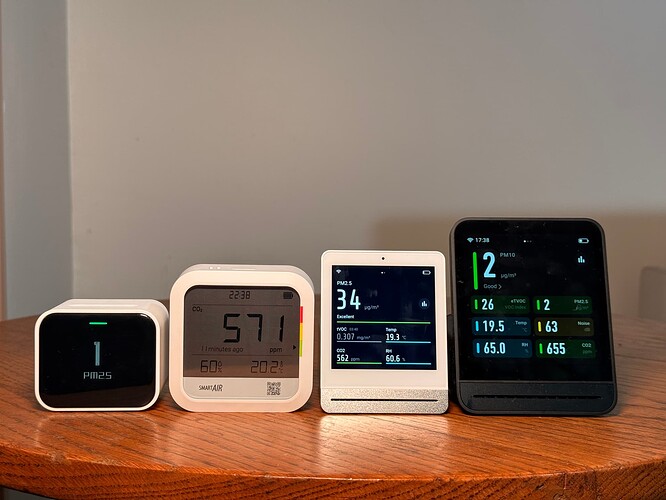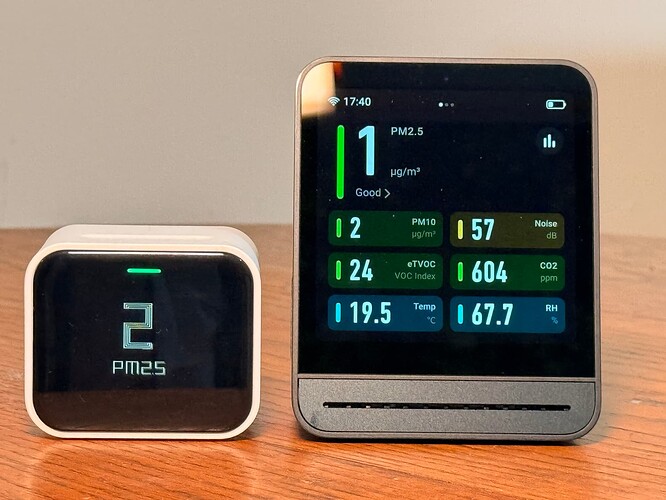Qingping is an IoT (Internet of Things) device company that I hadn’t heard of until 2022, around the time they entered the air quality monitoring space. With a large range of sensor and monitoring products, I wasn’t sure what to expect when they first sent me a couple of air quality monitors to test. While I was confident the devices must be decent as companies like SmartAir began to sell them, I also didn’t have high hopes as many companies that don’t focus solely on air quality monitors often overlook some of the most important aspects of these devices.
Please ignore the different readings from the monitors in this screenshot - I was moving them around for photos, so the readings aren’t as similar as they usually are.
However, my thoughts quickly changed after trying my first Qingping monitor (the Air Quality Monitor Gen 1) and the Qingping Air Quality Monitor Lite. Now, after using four of its monitors, I’ve quickly become a fan of the products, and I find myself recommending them quite often. Today, I wanted to make a quick summary post that discusses the Qingping air quality monitors as a range of devices rather than individually, as I have already done multiple times.
Qingping currently has four air quality monitors, and you can find my reviews of each here:
Qingping Air Quality Monitor (Gen 1):
Qingping Air Quality Monitor (Gen 2):
Qingping Air Quality Monitor Lite:
Qingping CO2 Monitor:
With four monitors (so far!), I think most people quickly arrive at the question, ‘Which monitor is right for me?’. Despite having four indoor air quality monitors, all of these have a specific target audience and a specific set of strengths.
Qingping Air Quality Monitor (Gen 1): This is the company’s original all-around air quality monitor. It measures a wide range of indoor air pollutants, has a beautiful screen, and is intended to be placed on a desk, table, or shelf.
Qingping Air Quality Monitor (Gen 2): This device is a direct upgrade to the Gen 1 and has a range of improvements over the first device. I believe it’s intended to replace the Gen 1, but both can still be found on sale. Gen 2 shares the same characteristics as the first generation but costs slightly more. Here’s a post detailing the differences between these two generations:
Qingping Air Quality Monitor Lite: A smaller, cheaper, and more portable air quality monitor that lacks a VOC sensor. It has a smaller screen and is intended less as a desk/shelf-based device and instead as a semi-portable monitor that you can take with you.
Qingping CO2 Monitor: A dedicated CO2 monitor that only measures CO2. This device has far better battery life than the others and is perfect as a portable device. It lacks the sensors of the AQM Lite, but it has other advantages in battery life, portability, and connectivity.
While these monitors differ in some key ways, they also share some common strengths. For one, they all feature good build quality and accurate sensors at competitive prices. Perhaps more interestingly, they all connect to the same apps (there are two, and you can choose between the two), except for the first-gen Air Quality Monitor, which can only use the Qingping+ app.
These devices also all share the traits of being easy to use but also providing some advanced options that I often don’t see on other monitors that put user experience first (looking at you, Airthings).
Generally speaking, I’ve also found the support from Qingping to be very good. I’ve had to interact with them a few times over the years, and I’ve found that they reply quite promptly to emails and often make fixes if possible. I’m not alone in this, and I’ve heard similar feedback from other community members (just check the comparison thread for the Qingping Air Quality Monitor Gen 1 and Gen 2, and you will see what I mean).
I think what many people find most appealing about these monitors, however, is the price. Actually, not just the price, but also what you get for the price. These monitors are on the affordable end of air quality monitors (in their respective categories), yet they offer some of the best user experiences and performance - even amongst far more expensive monitors.
While there are many positives to the Qingping series of devices, there are also some disadvantages. For example, I find it frustrating that there are two apps (Qingping IoT and Qingping+) for the same devices. While this wouldn’t be an issue if both had the exact same options, there are some differences between the two, and it causes a lot of confusion to new users. While I understand that the IoT app is targeted at businesses or offices that may need to give many people access to the data from the monitors, whereas Qingping+ is for normal customers, I don’t see why two separate apps with some different features are needed.
This also carries over to other integrations. For example, the Air Quality Monitor Lite can integrate with HomeKit, but I don’t believe this carries over to other Qingping devices. On the other hand, the Gen 1 can integrate with Home Assistant (unofficially), but the Gen 2 currently can’t.
Air Quality Monitor Lite (left) and Gen 2 (right)
I also find the feature sets between the devices confusing, and I wish they were more consistent. For example, I can set manual offsets for some monitors but not for others, even though all of them could support this feature. I wish these settings were similar to those of monitors with the required hardware.
I have also heard of other complaints, such as loud fan noises (primarily from the Air Quality Monitor Gen 1), but I can’t comment on these as I haven’t experienced them myself. However, it does seem to be quite a prevalent problem that can occur with these monitors. I have three Qingping monitors with PM sensors, and all of them have worked fine for up to two years that I’ve had them (touch wood!).
Overall thoughts
Although the Qingping devices aren’t perfect, I love how this company is making a splash in the air quality monitoring space. They’re offering monitors that use good components, are well-built, and have a fantastic feature set while still remaining relatively easy to use. Only a few other companies, like Aranet, have such a wide range of monitors, and I would like to see this range continue to expand.

